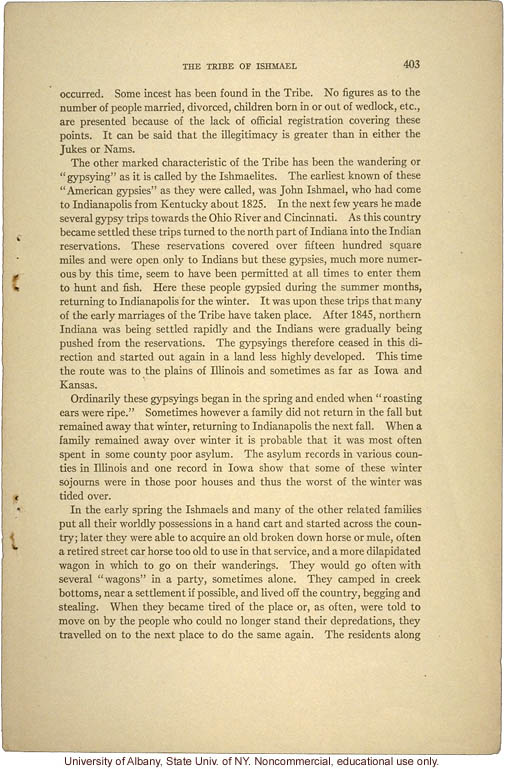The Tribe of Ishmael 403
occurred. Some incest has been found in the Tribe. No figures as to the number of people married, divorced, children born in or out of wedlock, etc., are presented because of the lack of official registration covering these points. It can be said that the illegitimacy is greater than in either the Jukes or Nams.
The other marked characteristic of the Tribe has been the wandering or "gypsying" as it is called by the Ishmaelites. The earliest known of these "American gypsies" as they were called, was John Ishmael, who had come to Indianapolis from Kentucky about 1825. In the next few years he made several gypsy trips towards the Ohio River and Cincinnati. As this country became settled these trips turned toward the north part of Indiana into the Indian reservations. These reservations covered over fifteen hundred square miles and were open only to Indians but these gypsies, much more numerous by this time, seem to have been permitted at all times to enter them to hunt and fish. Here these people gypsied during the summer months, returning to Indianapolis for the winter. It was upon these trips that many of the early marriages of the Tribe have taken place. After 1845, northern Indiana was being settled rapidly and the Indians were gradually being pushed from the reservations. The gypsyings therefore ceased in this direction and started out again in a land less highly developed. This time the route was to the plains of Illinois and sometimes as far as Iowa and Kansas.
Ordinarily these gypsyings began in the spring and ended when "roasting ears were ripe." Sometimes however a family did not return in the fall but remained away that winter, returning to Indianapolis the next fall. When a family remained away over winter it is probably that it was most often spent in some county poor asylum. The asylum records in various counties in Illinois and one record in Iowa show that some of these winter sojourns were in those poor houses and thus the worst of the winter was tided over.
In the early spring the Ishmaels and many of the other related families put all of their worldly possessions in a hand cart and started across the country; later they were able to acquire an old broken down horse or mule, often a retired street car horse too old to use in that service, and a more dilapidated wagon in which to go on their wanderings. They would go often with several "wagons" in a party, sometimes alone. They camped in creek bottoms, near a settlement if possible, and lived off the country, begging and stealing. When they became tired of the place or, as often, were told to move on by the people who could no longer stand their depredations, they traveled on to the next place to do the same again. The residents along
[end]


